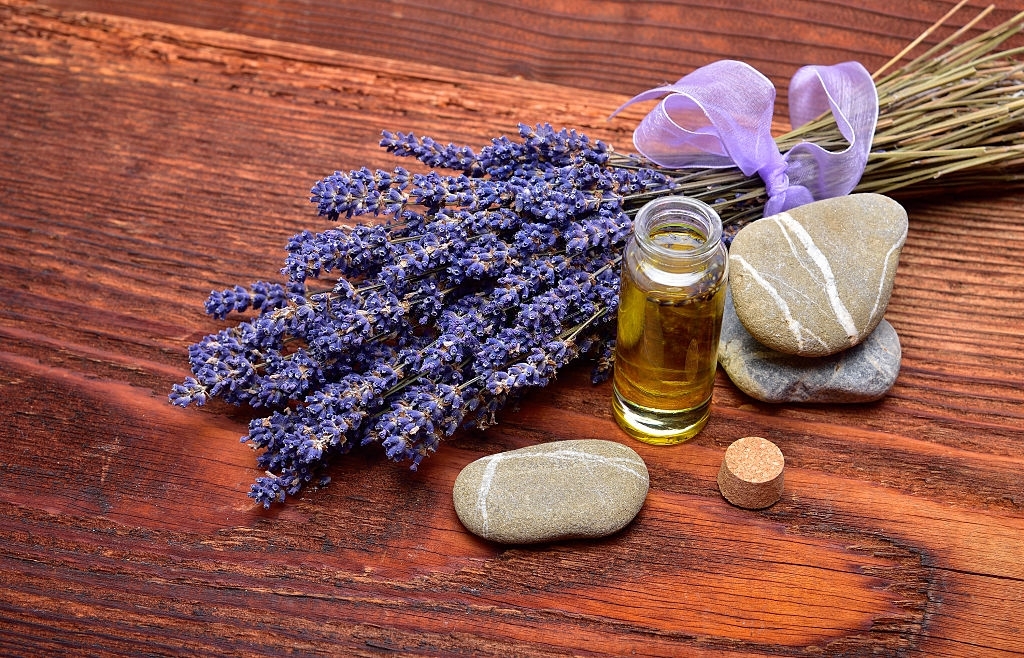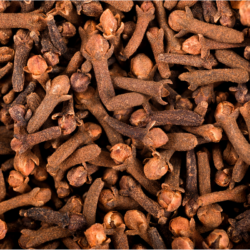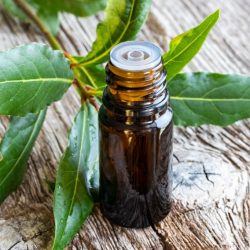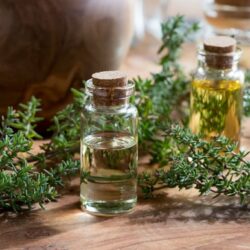Lavandin is the result of hybridisation (natural at first) between the two species Lavandula vera and Lavandula latifolia, and its aromatic profile is close to that of Lavandula vera (but with 6-8% camphor ). This hybridisation gave rise to four varieties of lavandin in Provence: Super, Grosso, Sumian and Abrial. Nowadays, lavandin is much more widely cultivated than lavender, because its flowers produce more essential oil.
A little history
At the time, wild lavender cutters had already noticed plants that were more developed than the others, which they called “big lavender”, “big lavender” or “bastard lavender”: these were in fact lavandins, resulting from the spontaneous hybridisation of true lavender and aspic.
This hybridisation is therefore due to foraging insects, mainly bees, which transport pollen from one species to another as they gather pollen from flower to flower. This phenomenon was verified in 1927 in the laboratories of the Chiris establishments in Grasse. It should therefore be noted that it was in 1925 that the Lavender quality was differentiated from the Lavandin quality, which led to a certain amount of uncertainty over these two qualities for several years.
The very first planting trials were carried out by transplanting wild lavandins from fields in the hills. These were therefore “populations” of lavandin. However, from 1925 onwards, the technique of cuttings became established, enabling lavandin cultivation to develop very rapidly. A similar technique was also applied to true lavender to obtain “clonal lavenders”. Fields of lavandin or clonal lavender are very homogeneous and regular, whereas the plants in fields of fine lavender are very disparate, which makes mechanisation difficult.
Propagation by cuttings has enabled the selection of ‘clones’ of particular economic interest, and rapid expansion of cultivation.
Lavender was distilled from the 18th century onwards, so that the sweet lavender from the fields of Provence could be harvested to make an essential oil. Lavender essential oil flourished from the outset, thanks in particular to the success of Grasse perfumers, who used the pretty lavandula augustifolia to create their fragrances.
- Lavandin is the result of hybridisation (natural at first) between the two species Lavandula vera and Lavandula latifolia, and its aromatic profile is close to that of Lavandula vera (but with 6-8% camphor )
- There are four types of Lavandin in Provence: Super, Grosso, Sumian and Abrial. Lavandin is grown mainly on the Valensole plateau in the Alpes-de-Haute-Provence, where it is intensively cultivated
- Lavandin is more widely cultivated than true lavender, because its flowers produce more essential oil
- Spike lavender(Lavandula latifolia) has larger, more pubescent leaves
This plant is much more vigorous than lavender and yields more per hectare.
Lavandin grows at altitudes of 200 metres and above, and can be recognised by its size, purple flowers and perfectly arranged spikes.
At the time when the cutters went out to gather wild lavender, they had already noticed plants that were more developed than the others, which they called “grande lavande”, “grosse lavande” or “lavande bâtarde”: these were lavandins, resulting from the spontaneous hybridisation of true lavender and aspic.
This hybridisation is due to foraging insects, mainly bees, which carry pollen from one species to another as they forage from flower to flower.
This phenomenon was verified in 1927 in the laboratories of the Chiris establishments in Grasse. Artificial pollination of aspic with lavender pollen produced 6 seeds, the sowing of which produced two individuals identified as “lavandins”.
In nature, there are many different types of lavandin, sometimes resembling true lavender, sometimes aspic. Everything in between is possible, which often makes morphological identification difficult.
It should be noted that it was in 1925 that the Lavender quality was differentiated from Lavandin, which led to a certain amount of uncertainty for several years about these two qualities.
The very first attempts to plant lavandin were made by transplanting wild lavandin collected in the hills into the fields.
These were therefore “populations” of lavandin.
But from 1925-1930, the technique of cuttings became established, enabling lavandin cultivation to develop very rapidly.
All lavandin plantations in existence today are made up of plants obtained by cutting clones. The same technique has also been applied to true lavender to obtain “clonal lavenders”.
Fields of lavandin or clonal lavender are very homogeneous and regular, whereas the plants in fields of fine lavender are very disparate in appearance, which makes mechanisation difficult.
Propagation by cuttings has made it possible to select ‘clones’ of particular economic interest, and to extend cultivation rapidly.
The distillation of lavender has been used since the 18th century to harvest the sweet lavender from the fields of Provence to make an essential oil. Lavender essential oil flourished from the outset, thanks in particular to the success of Grasse perfumers, who used the pretty lavandula augustifolia to create their fragrances.
What are the pharmacological properties of Lavandin flower essential oil?
Latin name:
- Lavandula hybrida clone super
Botanical family:
- Lamiaceae
Producing organ:
- Flowers
Known or suspected mode of action :
- Linalyl acetate is sedative, anti-inflammatory, spasmolytic and anti-platelet aggregation agent
Anti-inflammatory and analgesic properties:
Linalool is analgesic through its action on muscarinic, opioid and dopaminergic receptors.) In particular, it acts on N-methyl-d-aspartate (NMDA) receptors and glutamate receptors. Camphor is also analgesic, antineuralgic and anti-inflammatory.
Stimulating activity :
A mild stimulant, camphor stimulates the central nervous system and increases breathing amplitude.
Antispasmodic property :
A powerful antispasmodic, lavandin essential oil is calming, sedative and muscle-relaxing. Spasmolytic of intestinal smooth muscle throughlinalyl acetate, it is also an antispasmodic of vascular smooth muscle through activation of nitric oxide. Camphor also has a local relaxing effect on smooth and striated muscles. Spasmolytic on intestinal (especially) and tracheal smooth muscles, probably by stimulating the enzyme adenylate cyclase, thereby producing an increase in cAMP, linalool inhibits the release of ACh at the neuromuscular junction.
Antibacterial properties :
Anti-infective activity is enhanced by linalool. Antifungal, lavandin is active against Candida strains resistant to fluconazole. Linalool is also antiviral, showing strong activity against Adenovirus-2 (AVD-II), responsible for pharyngitis, pneumonia and gastro-enteritis. Camphor is a pulmonary antiseptic, bronchodilator and expectorant.
Anti-tumour activity :
Linalool is anti-tumour, stimulating various cytokines: IFN-γ, IL-13, IL-2, IL-21, IL-21R, IL-4, IL-6sR, TNF-α, and inducing a Th1-type immune response. It induces apoptosis.
Cardioprotective properties:
Linalyl acetate is cardioprotective, and also reduces the deleterious cardiovascular effects of acute exposure to nicotine. Camphor stimulates the heart and lungs.
Anti-platelet effect :
Marked antiaggregant and antithrombotic effect without pro-haemorrhagic effect.Linalyl acetate appears to be the most active anti-platelet agent.
Other properties :
- Active on SNA: Ʃ-
- Rubefacient effect linked to vasodilatation of peripheral vessels
- Gastro-protective when applied locally
- Anxiolytic, but improves attention
- Hypotensive, bradycardiac
- Hypnotic, anti-convulsant
- Antioxidant (inhibits lipid peroxidation), hypothermic
Does Lavandin essential oil require any precautions for use?
- Beware of possible gynaecomastitising effects with prolonged use. Linalool andlinalyl acetate inhibit the production of testosterone, which should be avoided over the long term in males as an endocrine disruptor
- For adults and pubescent adolescents only
- Contraindicated in pregnant (abortifacient) and breast-feeding women
- Use with caution by people suffering from autoimmune diseases, epilepsy, asthma, the elderly or Parkinson’s disease, as well as neurosensitive individuals
- Risk of neurotoxicity that may induce epileptic seizures in high doses
- Do not diffuse or use in the bath
- Do not swallow
- Dry inhalation is permitted
- Not for internal use
- Risk of drug interactions with essential oils containing more than 10% sesquiterpenes
- Not for animals
Medical literature and clinical trials:
- Ballabeni V, Tognolini M, Chiavarini M et all. Novel antiplatelet and antithrombotic activities of essential oils from Lavandula hybrida Reverchon “grosso”. Phytomedicine. 2004
- Barocelli E, Car F, Chiavarini M, Impicciatore M, Bruni R, Bianchi A, Ballabeni V. Antinociceptive and gastroprotective effects of inhaled and orally administered Lavandula hybrida Reverchon “Grosso” essential oil. Life Sciences, Volume 76, Issue 2, 26 November 2004
- Damião P. de Sousa, Genival A. S. Júnior, Luciana N. Andrade, Josemar S. Batista. Spasmolytic Activity of Chiral Monoterpene Esters. Nat. Prod
- Kotan R, Kordali S, Car A. Screening of antibacterial activities of twenty-one oxygenated monoterpenes. Z Naturforsch C J Biosci. 2007
- Marcos-Arias C, Eraso E, Madariaga L, Quindos G. In vitro activities of natural products against oral Candida isolates from denture wearers. BMC Complementary and Alternative Medicine 2011
- Peana AT, D’Aquila PS, Chessa ML, Moretti MD, Serra G, Pippia P. (-)-Linalool produces antinociception in two experimental models of pain. Eur J Pharmacol. 2003
- Peana AT, De Montis MG, Nieddu E, Spano MT, D’Aquila PS, Pippia P. Profile of spinal and supra-spinal antinociception of (-)-linalool. Eur J Pharmacol. 2004
- Peana AT, Marzocco S, Popolo A, Pinto A. (-)-Linalool inhibits in vitro NO formation: Probable involvement in the antinociceptive activity of this monoterpene compound. Life Sci. 2006
- Aprotosoaie Ana Clara, Hancianu Monica, Costache Irina, Miron Anca (2014). Linalool: A review on a key odorant molecule with valuable biological properties. Flavour and Fragrance Journal
- Lis-Balchin M, Hart S. Studies on the mode of action of the essential oil of lavender (Lavandula angustifolia P. Miller). Phytother Res. 1999
- Mazzanti Gabriela, Lu M, Salvatore G. (1998). Spasmolytic action of the essential oil from Hyssopus officinalis L. var. decumbens and its major components. Phytotherapy Research
- Chang MY, Shen YL. Linalool exhibits cytotoxic effects by activating antitumor immunity. Molecules. 2014
- Chang MY, Shieh DE, Chen CC, Yeh CS, Dong HP. Linalool Induces Cell Cycle Arrest and Apoptosis in Leukemia Cells and Cervical Cancer Cells through CDKIs. Int J Mol Sci. 2015
- Miriam M. Ehrnhöfer-Ressler, Kristina Fricke, Marc Pignitter, Joel M. Walker, Jessica Walker, Michael Rychlik, Veronika Somoza. Identification of 1,8-Cineole, Borneol, Camphor, and Thujone as Anti-inflammatory Compounds in a Salvia officinalis L. Infusion Using Human Gingival Fibroblasts. J. Agric. Food Chem. 2013
- Hamidpour Rafie, Hamidpour Soheila, Hamidpour Mohsen, Shahlari Mina. Camphor (Cinnamomum camphora), a traditional remedy with the history of treating several diseases. IJCRI – International Journal of Case Reports and Images
- Kim JR, Kang P, Lee HS, Kim KY, Seol GH. Car diovascular effects of linalyl acetate in acute nicotine exposure. Environmental Health and Preventive Medicine. 2017
- Ballabeni V, Tognolini M, Chiavarini M, Impicciatore M, Bruni R, Bianchi A, Barocelli E. Novel antiplatelet and antithrombotic activities of essential oil from Lavandula hybrida Reverchon “grosso”. Phytomedicine. 2004





